Rebecca’s Recipe of the Week: Smashed Cucumber Salad
This is an ideal recipe when you have 4 or 5 cucumbers looking at you from the bottom of your veg drawer. Smashing the cucumbers, which is apparently a classic Chinese recipe technique, changes the texture by making them more absorbent so they really soak up the dressing. It’s refreshing, easy, and makes an excellent accompaniment to an Asian-style noodle dish, such as this one for sesame noodles with smashed courgettes by Meera Sodha. (By the way, I served the noodle dish warm, which worked just fine.)
Chinese Smashed Cucumbers with Sesame Oil and Garlic
Serves 4 as a side dish
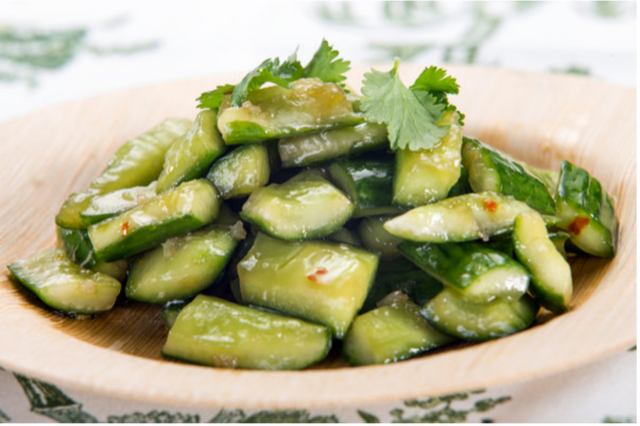
Ingredients
4 cucumbers
Salt
Sugar
1½ tablespoons rice vinegar
2 teaspoons sesame oil
2 teaspoons soya sauce
2 garlic cloves, grated
½ -1 Canalside chile, minced (to taste)
Small handful fresh coriander, chopped, for garnish
1 tablespoon toasted sesame seeds, for garnish
Preparation
Top and tail the cucumbers, and cut lengthwise into 4 long strips. Cut each strip into bite-sized pieces.
Using a rolling pin or (this is the less messy option) the side of a large knife, crush the cucumber pieces so that the skin begins to crack and the insides break down, releasing some of the seeds.
Place the crushed cucumber pieces in a colander and toss with a big pinch of salt and another of sugar. Fill a plastic bag with ice and place this on top of the cucumbers pieces, to weigh them down and at the same time chill them a bit. Leave for anywhere from 15 minutes to 4 hours.
Meanwhile, make the dressing: mix 1 teaspoon salt, 2 teaspoons sugar, and the rice vinegar. Stir until the salt and sugar have dissolved and then add the sesame oil and soya sauce.
When you are ready to serve, shake the cucumbers to drain off any remaining liquid and transfer to a beautiful flat plate. Toss with about half the dressing, and then add the garlic and as much chile as you like. Toss again, and then add more dressing to taste, until you’re pleased with the ensemble. Serve, garnished with fresh coriander and toasted sesame seeds.
Recipe adapted from New York Times Recipes.
Rob’s Recipe of the Week: Fancy Mash
Kohlrabi returns to the share this week and whilst I’m not sure mashed potato is really hot-weather suitable, this recipe looked too good to miss. This recipe makes a lot but can be scaled to suit your share size.
Mashed kohlrabi with brown butter
4 servings
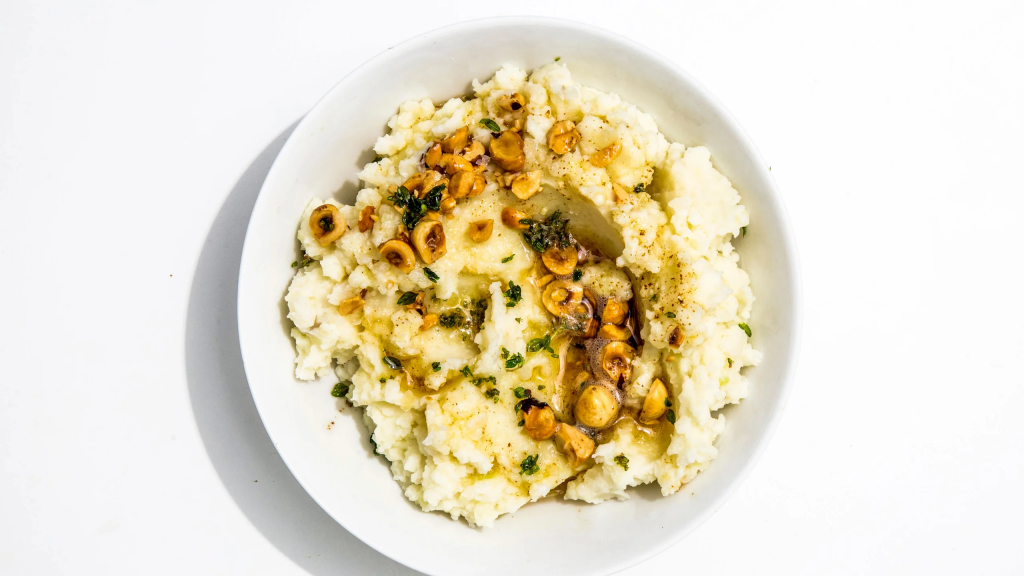
Ingredients
6 tablespoons unsalted butter
⅓ cup blanched hazelnuts
4 thyme sprigs
450g potatoes, peeled, cut into 2cm pieces
salt
900g kohlrabies, peeled, cut into 1cm pieces
⅓ cup double cream
Method
Heat butter in a small saucepan over medium. Cook hazelnuts until butter foams, then browns, about 5 minutes. Add thyme sprigs and cook until crisp, about 30 seconds. Immediately transfer to a bowl; spoon out nuts and coarsely chop.
Meanwhile, boil kohlrabi for 12-14 minutes, adding potatoes to the same pan after a couple of minutes. Whilst you wait, heat cream in a small saucepan over medium until warm.
Drain potatoes/kohlrabi and mash them. Stir in brown butter and warm cream; season with salt. Top mash with hazelnuts and crumble fried thyme over.
Taken from: https://www.bonappetit.com/recipe/mashed-kohlrabi-with-brown-butter
2020 – June news: Rain at Last
We’ve tried prayer, raindances and even some of the spells out of Harry Potter and finally it has worked as at last some decent rain arrived for our crops this week. This is particularly timely as we have been very busy getting some important crops in the ground: cabbages, kale and over 5000 leeks have all been planted in the last fortnight. Also, with the maincrop carrots and parsnips just emerging and getting established, the downpours are particularly welcome. The only question is: after 3 months of moaning about how dry it all is, how long before the growers start moaning that it’s too wet?
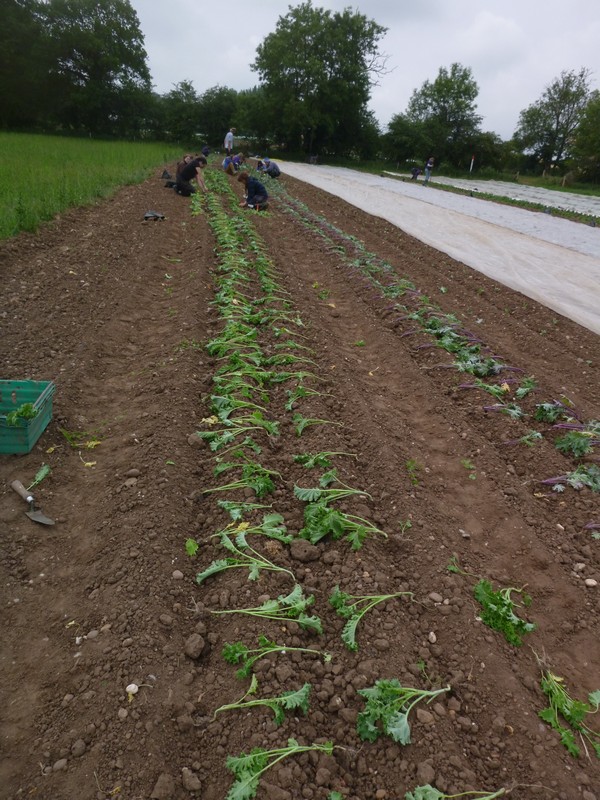
Kale awaiting planting 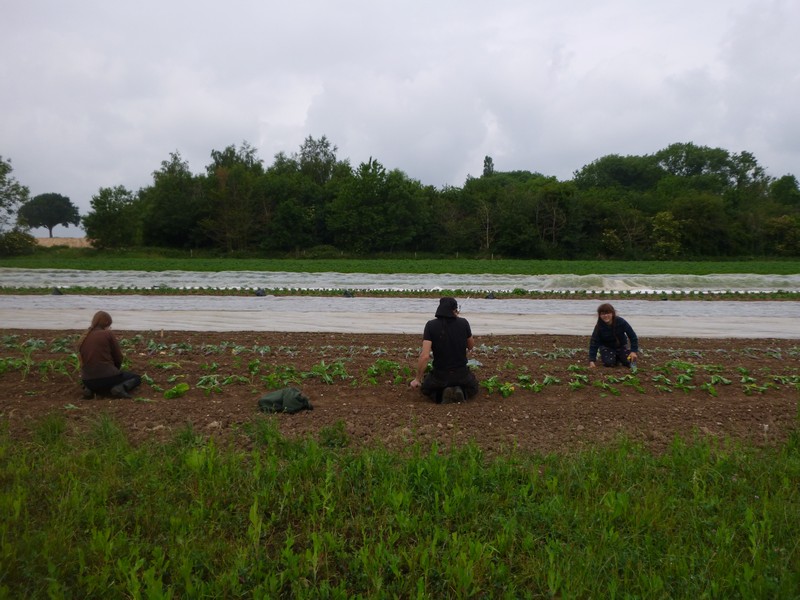
Planting team at work
Rebecca’s Recipe of the Week: Why Eat Normal Things When You Can Eat Weird Things?
A while ago I tried a recipe for whole broad beans cooked in a tomato sauce, and it was pretty good. It set me thinking whether you could actually cook the normally-discarded pods (husks?) that are left over when you shell broad beans. It turns out you can. I mentioned this to several friends, who variously told me I’d gone nuts, or that it sounded like the sort of thing people eat in Siberia. What can I say? I thought it was pretty good. We ate this with brown rice and a topping of salted yoghurt, and a shredded carrot salad on the side.
If you would like a normal recipe for broad beans, I strongly recommend this one: spaghetti with broad beans, bread crumbs and marjoram.
Broad Bean Stew
Serves 2
Ingredients
2 tablespoons olive oil
1 large onion, peeled and sliced
Salt and pepper
Leftover husks from about 500g young broad beans (that’s about 300g of broad-bean husks)
Juice of half a lemon
2-3 tablespoons fresh herbs (I used lemon thyme, sage, and dill)
½ cup water
Preparation
Heat the olive oil over low heat and add the sliced onion and a pinch of salt. Cook for 10 minutes, until the onion is soft but not brown.
Meanwhile assess the broad bean husks. You want bright, green, fresh-looking ones. Discard any that look discoloured. Remove any stringy bits along the sides, rather as you’d remove the strings from off the sides of runner beans. Cut the husks into 1-inch pieces.
Add the broad beans to the onions, stir, and cook for a minute.
Add the water, stir, cover, and simmer gently for about 15 minutes, or until the husks are tender. Top up with more water if it seems to be drying out.
Once the husks are tender, add the fresh herbs and lemon juice, and season with freshly-ground black pepper.
If you wish, you can also mix in some cooked broad beans, to make a double-broad-bean stew.
Serve on brown rice with a topping of salted yoghurt mixed with preserved lemon (if you happen to have any to hand).
Rob’s Recipe of the Week: An Unusual Use for Celery
This week I thought I was going to have to go with a Celery soup recipe, but then I came across this gin cocktail which looks worth a try and I guess the celery can still be used as a soup base once it’s served its alcoholic purpose!
Celery tonic

Ingredients:
1 celery stalk, chopped
1 tablespoon sugar
30ml fresh lemon juice
60ml gin
Lemon twist (for serving)
Method:
Muddle celery with sugar and lemon juice in a cocktail shaker, 1 minute. Add gin, fill shaker with ice, and shake until outside of shaker is frosty, about 30 seconds. Strain into a rocks glass filled with ice and garnish with a lemon twist.
Taken from: https://www.bonappetit.com/recipe/celery-tonic
Rebecca’s Recipe of the Week: A Very Elaborate Borscht
In case you have a little time on your hands just now, here is an excellent use of a few hours. The result is the best borscht I, at least, have ever tasted. Alissa Timoshkina, whose recipe this is, notes that if you can make the broth 24 hours in advance, ‘you will be rewarded with an even better tasting soup, but a few hours of resting will also do the trick’.
For the red cabbage sauerkraut, I recommend you get in touch with Canalside member Erica Moody, who makes superb sauerkrauts of all sorts.
Borscht
Serves 4
Ingredients
unrefined sunflower oil, for frying and roasting
1 large onion, finely diced
1 carrot, peeled and grated
6 raw beetroots
2 red peppers
2 tablespoons tomato purée
2 litres cold water
2 bay leaves
1 tablespoon black peppercorns
1 tablespoon coriander seeds
1 tablespoon fennel seeds
4 garlic cloves, peeled
bunch of dill
small bunch of flat leaf parsley
2 garlic cloves, grated
500g red cabbage sauerkraut
2 tablespoons pomegranate molasses
1 red onion
1 tablespoon brown sugar
400g can red kidney beans
2 teaspoons smoked paprika
4 tablespoons soured cream
salt
Preparation
Heat up a tablespoon of sunflower oil in a large pan and fry the onion and carrot for about 8 minutes until golden. Meanwhile, peel and grate 2 of the beetroots and core, deseed and thinly slice 1 red pepper. Add the vegetables to the pan together with the tomato purée and a splash of water. Season with salt to taste and fry for a further 5–8 minutes.
Top with the measured cold water, add the bay leaves along with the peppercorns and all the seeds, whole garlic cloves and half the bunches of dill and parsley. Season with a tablespoon of salt and bring to the boil. Reduce the heat, add the grated garlic and half the sauerkraut with its brine and simmer, covered, over a low heat for 40 minutes–1 hour.
Turn off the heat and let the borscht rest for another hour, while you prepare the rest of the elements.
So far, so good, but here is where the recipe starts to deviate from the norm quite a lot: to prepare the vegetables that will grace the plate and also add extra flavour and texture to the soup, you will need to do a bit of roasting.
Start by preheating the oven to 160°C fan/Gas Mark 4. Peel the remaining 4 beetroots, cut into wedges and dress with oil, salt and the pomegranate molasses. Peel the red onion, cut into wedges and season with salt and the brown sugar to bring out their sweetness and promote caramelization. Place on a roasting tray with the beetroot and roast together for 30 minutes. Drain the kidney beans, then dress them with salt, oil and the smoked paprika. Core and deseed the remaining red pepper, then cut into thin strips and dress with salt and oil. Roast the beans and pepper together, as they will need only 10–15 minutes.
When ready to serve, strain the broth through a sieve or a muslin cloth, discarding the solids. All we need is that rich broth! Reheat again if necessary. Next, create layers of texture and flavour in each bowl by adding a heaped tablespoon of the remaining sauerkraut to each, as well as a handful of roasted beetroot, onion, kidney beans and red pepper. Top each bowl with the hot broth and add a dollop of soured cream and a generous sprinkle of the remaining dill and parsley, chopped. The intensity of the flavours and textures of this dish is beyond words, while the look of the bowl will seduce the eye without a doubt.
Recipe from Alissa Timoshkina, Salt & Time: Recipes from a Russian Kitchen (2019).
2020 – May news: Don’t Mind the Gap
The spell from mid May to mid June is the dreaded ‘hungry gap’: the time when the growers are scratching around down the back of the sofa desperate for anything, anything at all vaguely veg-like to put in the share. Well, don’t know if you’ve noticed but that hasn’t really happened this year!
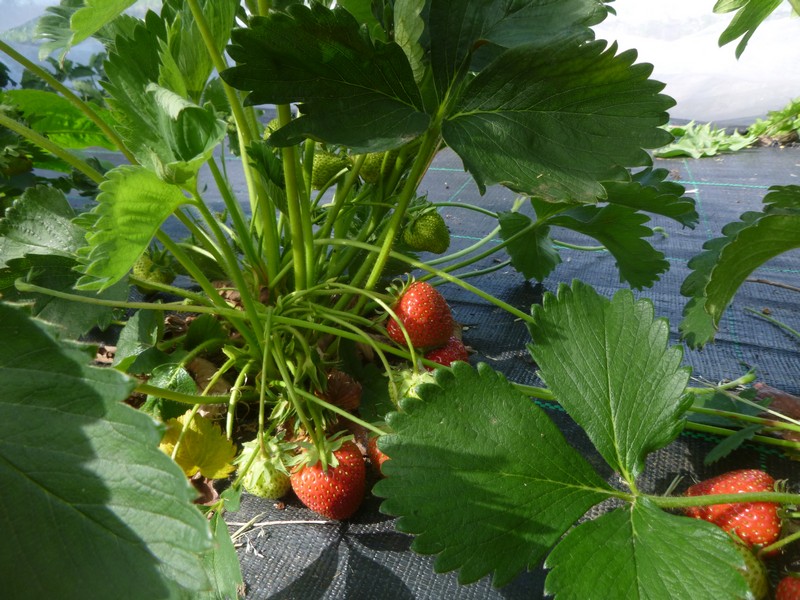
Early strawberries, ripe for the picking 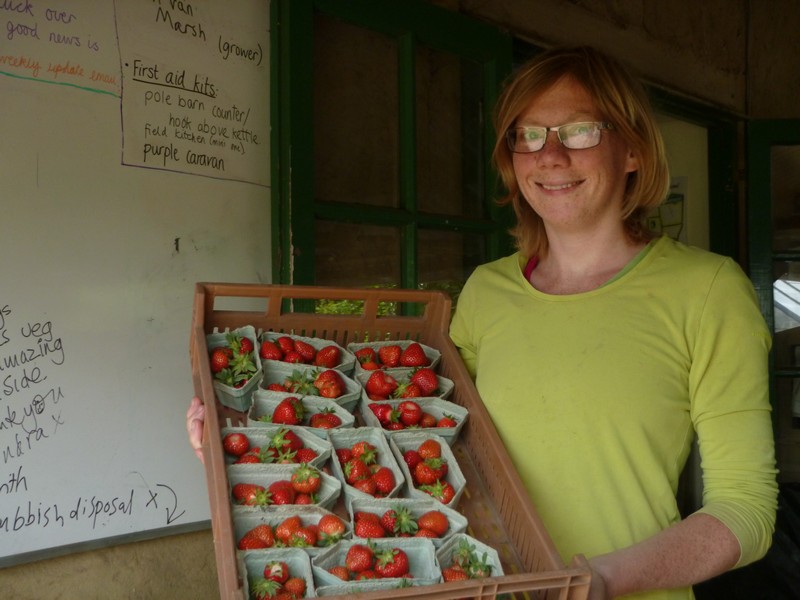
The first strawberry shares
New projects (e.g. the strawberries) have come good, new varieties have thrived (e.g. overwintering broad beans and onions) and our usual staples are all here a bit earlier (e.g. tunnel carrots and potatoes).
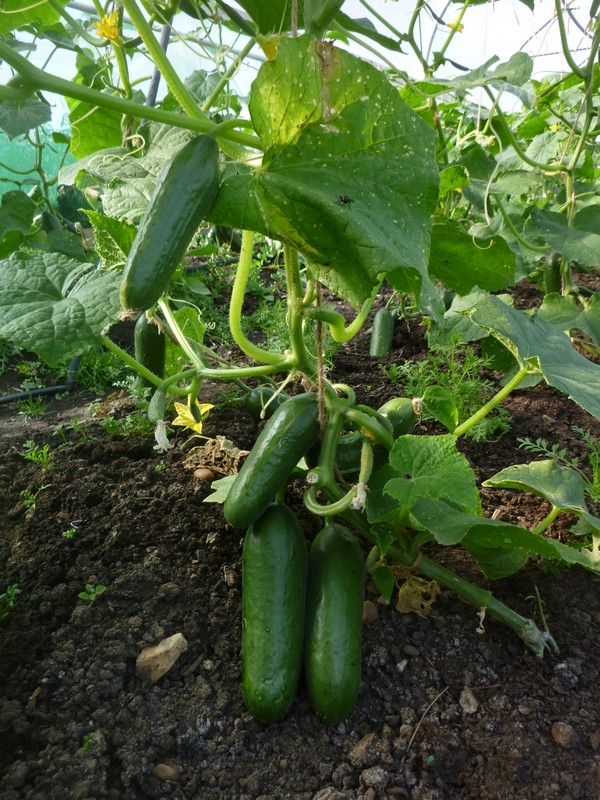
Bumperlicious cucumbers 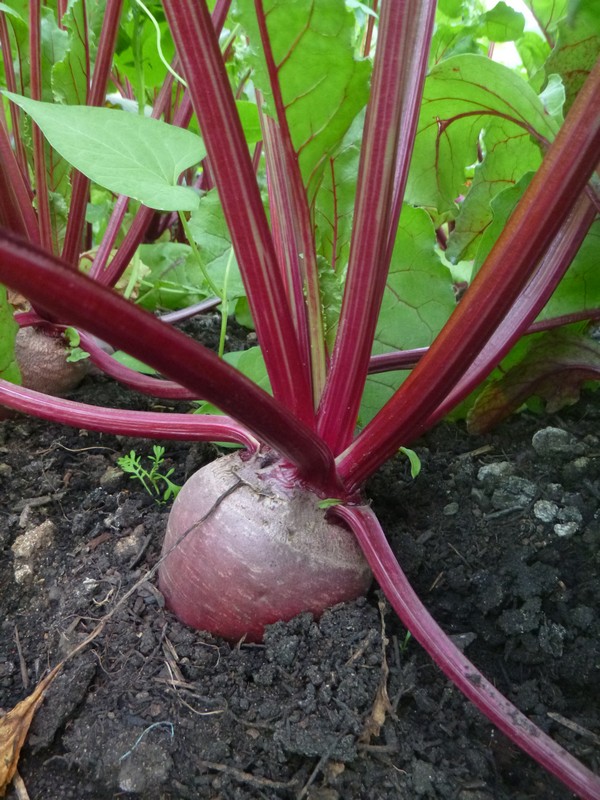
Tunnel beets looking swell!
The weather has been outstanding for early production (provided we can get enough water out there), but most of all it is down to our superb volunteers, toiling away – at a social distance – in the baking heat every Wednesday and Saturday. You have kept the crops weed free and got the seeds sown, and kept us well ahead of the game at a crucial time. Enjoy the bumper ‘hungry gap’ share!
Rob’s Recipe of the Week: Potato salad with a new season variation
Potato salad is something that drops off my radar too frequently, but this week we got a large haul of radishes and new potatoes with more expected next week. With that it mind it seems a good idea to make something fresh and easy for lunch in the sun, enjoy!
Potato and radish salad
Serves 4

Ingredients
500g new potato, sliced
3 tbsp crème fraîche (I think Oatly and Alpro both do alternatives)
1 tbsp grainy mustard
1 bunch chive, snipped
200g radishes, sliced
Method
Cook the potatoes in a large pan of boiling, salted water for 8-10 mins or until tender. Drain and allow to cool for 10 mins.
Mix the crème fraîche, grainy mustard and chives with some seasoning, then toss through the radishes and potatoes before serving.
Adapted from: https://www.bbcgoodfood.com/recipes/potato-radish-salad
Rebecca’s Recipe of the Week: Spare Squash
I managed to accumulate several Canalside squash in my fridge over the last fortnight. I was going to make them into a cake (and if that’s what you’d like I commend to you this recipe for brown butter spice bread.) Instead I ended up making this easy, flavourful roast squash with a spicy, umami-rich chile oil. The chile oil complements the unctuousness of the squash and is absolutely delicious. Serve it with steamed greens for a colourful and satisfying dinner.
Whole Roast Squash with Black Bean and Chile Oil
Serves 2
Ingredients
2 Canalside squash shares (not that the size is super important)
2 tablespoons rapeseed oil
3 cloves garlic, peeled and sliced fine
1 tablespoon salted black beans, rinsed
a fragment of a Canalside chile, or 1-2 teaspoons chile flakes
1 tablespoon soya sauce
1 teaspoon caster sugar
Preparation
Heat your oven to 180C. Remove the seeds from the squash.1 Put the de-seeded squash on a baking sheet and roast it until it is tender and golden, 45-75 minutes. Remove from the oven.
Meanwhile, make the black bean and chile oil. Over a low flame, heat the rapeseed oil in a small saucepan for 1 minute. Add the garlic and fry gently for 1-2 minutes, until the garlic is golden brown and a little sticky. Remove the pan from the heat and add the black beans. Return to the heat and add the chile, soya sauce, sugar and 2 tablespoons of water. Heat for about 20 seconds, stirring constantly. Remove from the heat and let cool.
When the squash is cooked, you can either cut it into slices and serve warm, or let it cool before slicing. In either case drizzle the black bean and chile oil over the top and serve with a side of steamed green vegetables.
Recipe adapted from Meera Sodha, East (2019).
Rob’s Recipe of the Week: A ‘Harvesting Gap’ Salad
I tried a variation of this recipe tonight and it went down very well, it used a lot of Canalside produce and felt like an incredibly healthy meal! Feel free to adapt to what you have – I swapped the salad for boiled greens, the canned lentils for boiled red lentils and omitted the pomegranate seeds. I would be tempted to suggest some soy sauce on the lentils to cut through the sweetness of the other components (rocket probably does this job if you have it).
Roasted beets and squash with tahini
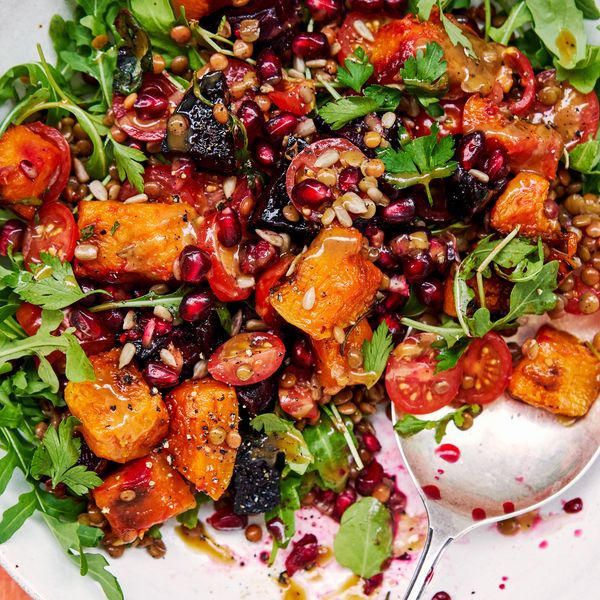
Ingredients:
2 large raw beetroots, peeled and chopped
1 medium squash, deseeded and chopped (no need to peel our squash)
Leaves from 2 rosemary sprigs, chopped
1 tbsp olive oil
1 tbsp maple syrup (I used honey)
1 × 400g tin brown lentils, drained and rinsed
200g mixed rocket and other salad leaves
200g cherry tomatoes, quartered
4 tbsp sunflower seeds
Handful fresh parsley, finely chopped
4 tbsp pomegranate seeds
Salt and black pepper
For the tahini vinaigrette:
3 tbsp extra-virgin olive oil
1 tbsp tahini
1 tsp maple syrup (I used golden syrup)
1 tsp Dijon mustard
1–2 tsp balsamic vinegar (to taste)
Method:
Preheat the oven to 200°C fan.
Place the beetroot, butternut squash and rosemary in a large baking tray or roasting tin and toss in the olive oil, maple syrup and some salt and pepper until evenly coated. Spread out the vegetables in a single layer and roast in the oven for 40–50 minutes, stirring once halfway through the cooking time, until tender and slightly crisp.
Meanwhile, combine all the ingredients for the tahini vinaigrette together in a bowl, seasoning to taste with salt and pepper.
Place the lentils and salad leaves in large bowl with the cherry tomatoes and a small drizzle of the tahini vinaigrette and toss until evenly coated.
Transfer the dressed salad to a serving dish and add the still-warm roast vegetables in layers with the sunflower seeds, parsley and pomegranate seeds. Finish with a generous drizzle of vinaigrette.
Adapted from: https://thehappyfoodie.co.uk/recipes/roasted-beets-and-butternut-squash-with-tahini